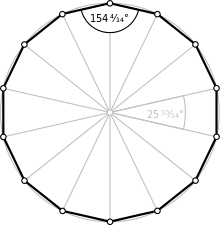Tetradecagon
A tetradecagon or 14-gon is a shape with 14 sides and 14 corners.
| Regular tetradecagon | |
|---|---|
 A regular tetradecagon | |
| Type | Regular polygon |
| Edges and vertices | 14 |
| Schläfli symbol | {14}, t{7} |
| Coxeter diagram | |
| Symmetry group | Dihedral (D14), order 2×14 |
| Internal angle (degrees) | ≈154.2857° |
| Dual polygon | Self |
| Properties | Convex, cyclic, equilateral, isogonal, isotoxal |
Regular tetradecagon
changeA regular tetradecagon has Schläfli symbol {14} and can be constructed as a quasiregular truncated heptagon, t{7}, which alternates two types of edges.
Area
changeThe amount of space a regular tetradecagon takes up is
The area of a regular tetradecagon of side length a is given by
a is the length of one of its sides.
Dissection
changeCoxeter states that every parallel-sided 2m-gon can be divided into m(m-1)/2 rhombs. For the regular tetradecagon, m=7, and it can be divided into 21: 3 sets of 7 rhombs. This decomposition is based on a Petrie polygon projection of a 7-cube, with 21 of 672 faces. [1] The list A006245 defines the number of solutions as 24698, including up to 14-fold rotations and chiral forms in reflection.
Numismatic use
changeThe regular tetradecagon is used as the shape of some commemorative gold and silver Malaysian coins, the number of sides representing the 14 states of the Malaysian Federation.[2]
References
changeOther websites
change- Eric W. Weisstein, Tetradecagon at MathWorld.